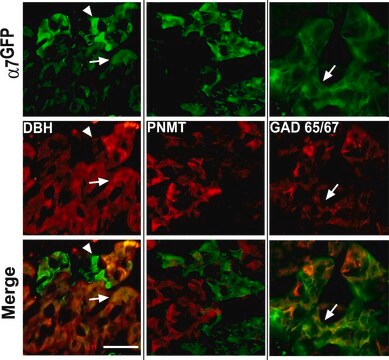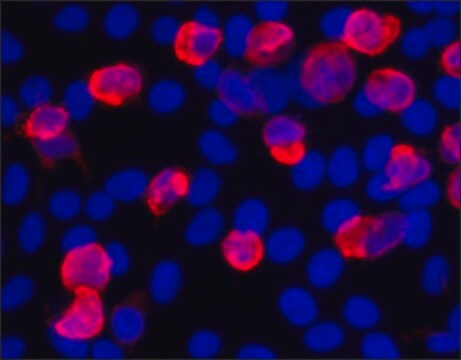推荐产品
生物源
rabbit
品質等級
共軛
unconjugated
抗體表格
IgG fraction of antiserum
抗體產品種類
primary antibodies
無性繁殖
polyclonal
形狀
buffered aqueous solution
分子量
antigen 45 kDa
物種活性
rat
包裝
antibody small pack of 25 μL
技術
immunohistochemistry (formalin-fixed, paraffin-embedded sections): 1:10,000 using rat brain sections
microarray: suitable
western blot: 1:10,000 using rat brain cytosolic fraction
UniProt登錄號
儲存溫度
−20°C
目標翻譯後修改
unmodified
基因資訊
human ... GLUL(2752)
mouse ... Glul(14645)
rat ... Glul(24957)
一般說明
抗谷氨酰胺合成酶,由合成肽作为免疫原,在兔体内产生,所用合成肽对应于小鼠谷氨酰胺合成酶(GS)C末端并与钥孔血蓝蛋白(KLH)偶联。这一序列在人、牛、大鼠、仓鼠和猪的GS中相同,在鸡的 GS中高度保守。哺乳动物体内,GS以相同45 kDa亚基构成的八聚体形式存在。它位于各物种的神经胶质细胞中。它主要存在于大脑星形胶质细胞和视网膜穆勒(Muller)胶质细胞,支持神经元使用谷氨酸作为神经递质。GS 存在于多个大脑区域,包括海马、大脑皮层、新纹状体和小脑颗粒层,与谷氨酸受体分布密度高的部位相对应。
特異性
抗谷氨酰胺合成酶识别大鼠谷氨酰胺合成酶 (GS) (45 kDa)。免疫印迹中 GS 的染色可被 GS 免疫肽(n 端添加赖氨酸的 357-373 位氨基酸)特异性抑制。
免疫原
对应于小鼠谷氨酰胺合成酶 (GS) C 末端区域的合成肽(氨基酸 357-373。该序列在人、牛、大鼠、仓鼠和猪 GS 以及高度保留的鸡
Gs(单个氨基酸取代)。
Gs(单个氨基酸取代)。
應用
免疫印迹:用大鼠脑胞质片段提取物确定的最小工作抗体稀释度为1:10,000。
免疫组化:用福尔马林固定、石蜡包埋大鼠脑切片确定的最小工作抗体稀释度为1:10,000。
抗谷氨酰胺合成酶抗体用于通过免疫印迹和免疫组化检测和定位GS。
生化/生理作用
谷氨酰胺合成酶(GS)催化谷氨酸进行酰胺化反应形成谷氨酰胺。普遍认为,GS是大脑中的关键酶,参与神经元释放的兴奋性神经递质谷氨酸的再循环、神经递质信号的终止以及氨的脱毒过程。GS 活性是星形胶质细胞的有用标志物,同时也是视网膜重要的分化特征。GS 上调是反应性星形细胞增多症的特征,脊髓损伤后GS活性水平升高。大脑受阿尔茨海默氏病影响时,星形胶质细胞的GS表达减少,在淀粉样斑块附近尤其明显。GS在部分人类肝细胞癌中上调,表明其表达可能与肿瘤复发有关,因为表达GS的肿瘤与细胞外谷氨酰胺供应无关。
外觀
0.01 M 磷酸盐缓冲液 (pH 7.4) 中的溶液,含 15 mM 叠氮化钠
免責聲明
除非我们的产品目录或产品随附的其他公司文件中另有说明,否则我们的产品仅用于研究用途,不得用于任何其他目的,包括但不限于未经授权的商业用途、体外诊断用途、体外或体内治疗用途或任何类型的人类或动物消费或应用。
未找到合适的产品?
试试我们的产品选型工具.
儲存類別代碼
12 - Non Combustible Liquids
水污染物質分類(WGK)
WGK 2
閃點(°F)
Not applicable
閃點(°C)
Not applicable
其他客户在看
Effects of bevacizumab (Avastin) on retinal cells in organotypic culture
Kaempf S, et al.
Investigative Ophthalmology & Visual Science, 49(7), 3164-3171 (2008)
Deniz Dalkara et al.
Molecular therapy : the journal of the American Society of Gene Therapy, 19(9), 1602-1608 (2011-04-28)
Mutations in over 80 identified genes can induce apoptosis in photoreceptors, resulting in blindness with a prevalence of 1 in 3,000 individuals. This broad genetic heterogeneity of disease impacting a wide range of photoreceptor functions renders the design of gene-specific
Ying Zhu et al.
mBio, 8(4) (2017-08-16)
While glutamine is a nonessential amino acid that can be synthesized from glucose, some cancer cells primarily depend on glutamine for their growth, proliferation, and survival. Numerous types of cancer also depend on asparagine for cell proliferation. The underlying mechanisms
Peter X Shaw et al.
Investigative ophthalmology & visual science, 57(11), 5083-5092 (2016-09-30)
We have previously demonstrated that soluble adenylyl cyclase (sAC) is necessary for retinal ganglion cell (RGC) survival and axon growth. Here, we further investigate the role of sAC in neuronal differentiation during retinal development. Chx10 or Math5 promoter-driven Cre-Lox recombination
Ala Moshiri et al.
Investigative ophthalmology & visual science, 58(3), 1709-1718 (2017-03-23)
Small guanosine triphosphatase (GTPase) ADP-ribosylation factors (Arfs) regulate membrane traffic and actin reorganization under the control of GTPase-activating proteins (GAPs). Arap1 is an Arf-directed GAP that inhibits the trafficking of epidermal growth factor receptor (EGFR) to the early endosome, but
我们的科学家团队拥有各种研究领域经验,包括生命科学、材料科学、化学合成、色谱、分析及许多其他领域.
联系技术服务部门









